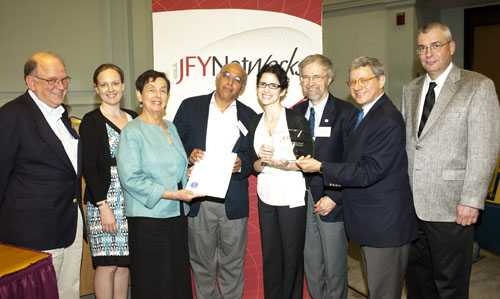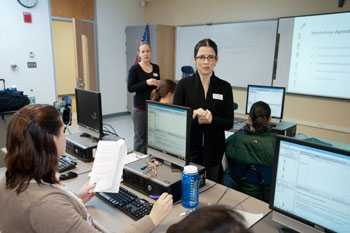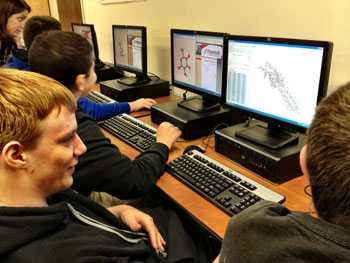On May 30, the Office of Educational Innovation and Technology’s (OEIT) Software Tools for Academics and Researchers (STAR) program was awarded a JFYNet Innovation Award for Technology in Education at a ceremony at the Massachusetts State House. The award recognizes significant contributions to the cause of improving high school student achievement through the use of technology.
This year’s awards were focused on innovative uses of technology in science, technology, engineering and mathematics (STEM) education and college readiness. The awards are presented byJFYNetWorks, a Boston-based nonprofit enterprise that, for the past 12 years, has helped schools effectively use technology to improve student success.
OEIT began a collaborative project with JFYNetWorks and Shannon Donnelly, a biology teacher at North Shore Technical High School in Middleton, Mass., in the spring of 2010. The goal was to adapt StarBiochem, a molecular 3-D visualizer developed and used at MIT, to help high school students better understand the four basic biological macromolecules — proteins, sugars, fats, and nucleic acids — a topic that is included in Massachusetts standardized tests.
This effort has resulted in the development and implementation of inquiry-based activities that enable high school students to use StarBiochem to explore the molecular structures typically encountered within introductory biology courses and high school biology curricula. Gary Kaplan, director of JFYNetWorks, said, “STAR creates vivid, colorful, dynamic online visualizations of molecules so that students can see what they look like in three dimensions [and] manipulate them.”
Over several months, research scientists Lourdes Alemán and Alison Brauneis, of MIT biology professor Graham Walker's HHMI-funded Education Group, worked with developer Sara Bonner of the OEIT STAR team to extend StarBiochem functionality. The challenge was that most 3-D protein visualizers, including StarBiochem, only allow the visualization and manipulation of protein structures found in a large online repository called the Protein Data Bank. It was impossible to visualize the more simple building blocks of the four macromolecules, including those of proteins, without first opening a structure containing a protein. To fill this gap, Alemán and Brauneis identified protein structures from the Protein Data Bank containing examples of building blocks from the other three classes of macromolecules, and Bonner isolated and bundled the molecules of interest within StarBiochem.
The team created more than 50 new structures in StarBiochem for students to view interactively, including examples that students would have learned about in high school biology classes, such as glucose, phospholipids and DNA, among others. In collaboration with Donnelly, Alemán and Brauneis created a StarBiochem activity to explore the four basic classes of macromolecules and their building blocks. Alemán and Brauneis also added an assessment module to test students’ knowledge.
Dave Stanley, an education specialist at JFYNetWorks who facilitated the implementation of StarBiochem at North Shore Technical High School, noted, “Lourdes Alemán's and Alison Brauneis' dedication and responsiveness have made this effort successful.”
This collaborative effort has been mutually beneficial. The STAR program gained invaluable insight on the pedagogical approaches that are better suited for high schools. At the same time, supporting curricula in a high school environment has proved informative for their use at MIT and worldwide.
It has also yielded more joint projects with JFYNetWorks, and identified StarGenetics, a virtual genetics-experiment simulator, as a useful tool for teaching genetics. The hurdle to using the tool was that high school curriculum introduces genetics to students by illustrating the classic experiments that Gregor Mendel performed with garden peas, an organism that was not yet implemented in StarGenetics.
Stacie Bumgarner, who was also part of the HHMI-funded Education Group, worked with OEIT STAR developer Ivica Ceraj to build a new StarGenetics user interface for garden peas. The tool will be used at North Shore Technical High School; JFYNetWorks also intends to involve more schools. This spring, Malden High School in Malden, Mass., began to integrate the STAR tools into its biology curriculum.
Kaplan expressed his gratitude to OEIT and the Education Group, saying, “These cutting-edge teaching devices are available to students at the high school and even the middle school level. These researchers, these innovators — these educators — are changing the way science is taught in our high school and middle school classrooms. We are proud to be working with OEIT and STAR to transform STEM education.”
This year’s awards were focused on innovative uses of technology in science, technology, engineering and mathematics (STEM) education and college readiness. The awards are presented byJFYNetWorks, a Boston-based nonprofit enterprise that, for the past 12 years, has helped schools effectively use technology to improve student success.
OEIT began a collaborative project with JFYNetWorks and Shannon Donnelly, a biology teacher at North Shore Technical High School in Middleton, Mass., in the spring of 2010. The goal was to adapt StarBiochem, a molecular 3-D visualizer developed and used at MIT, to help high school students better understand the four basic biological macromolecules — proteins, sugars, fats, and nucleic acids — a topic that is included in Massachusetts standardized tests.
This effort has resulted in the development and implementation of inquiry-based activities that enable high school students to use StarBiochem to explore the molecular structures typically encountered within introductory biology courses and high school biology curricula. Gary Kaplan, director of JFYNetWorks, said, “STAR creates vivid, colorful, dynamic online visualizations of molecules so that students can see what they look like in three dimensions [and] manipulate them.”
Over several months, research scientists Lourdes Alemán and Alison Brauneis, of MIT biology professor Graham Walker's HHMI-funded Education Group, worked with developer Sara Bonner of the OEIT STAR team to extend StarBiochem functionality. The challenge was that most 3-D protein visualizers, including StarBiochem, only allow the visualization and manipulation of protein structures found in a large online repository called the Protein Data Bank. It was impossible to visualize the more simple building blocks of the four macromolecules, including those of proteins, without first opening a structure containing a protein. To fill this gap, Alemán and Brauneis identified protein structures from the Protein Data Bank containing examples of building blocks from the other three classes of macromolecules, and Bonner isolated and bundled the molecules of interest within StarBiochem.
The team created more than 50 new structures in StarBiochem for students to view interactively, including examples that students would have learned about in high school biology classes, such as glucose, phospholipids and DNA, among others. In collaboration with Donnelly, Alemán and Brauneis created a StarBiochem activity to explore the four basic classes of macromolecules and their building blocks. Alemán and Brauneis also added an assessment module to test students’ knowledge.
Dave Stanley, an education specialist at JFYNetWorks who facilitated the implementation of StarBiochem at North Shore Technical High School, noted, “Lourdes Alemán's and Alison Brauneis' dedication and responsiveness have made this effort successful.”
This collaborative effort has been mutually beneficial. The STAR program gained invaluable insight on the pedagogical approaches that are better suited for high schools. At the same time, supporting curricula in a high school environment has proved informative for their use at MIT and worldwide.
It has also yielded more joint projects with JFYNetWorks, and identified StarGenetics, a virtual genetics-experiment simulator, as a useful tool for teaching genetics. The hurdle to using the tool was that high school curriculum introduces genetics to students by illustrating the classic experiments that Gregor Mendel performed with garden peas, an organism that was not yet implemented in StarGenetics.
Stacie Bumgarner, who was also part of the HHMI-funded Education Group, worked with OEIT STAR developer Ivica Ceraj to build a new StarGenetics user interface for garden peas. The tool will be used at North Shore Technical High School; JFYNetWorks also intends to involve more schools. This spring, Malden High School in Malden, Mass., began to integrate the STAR tools into its biology curriculum.
Kaplan expressed his gratitude to OEIT and the Education Group, saying, “These cutting-edge teaching devices are available to students at the high school and even the middle school level. These researchers, these innovators — these educators — are changing the way science is taught in our high school and middle school classrooms. We are proud to be working with OEIT and STAR to transform STEM education.”








